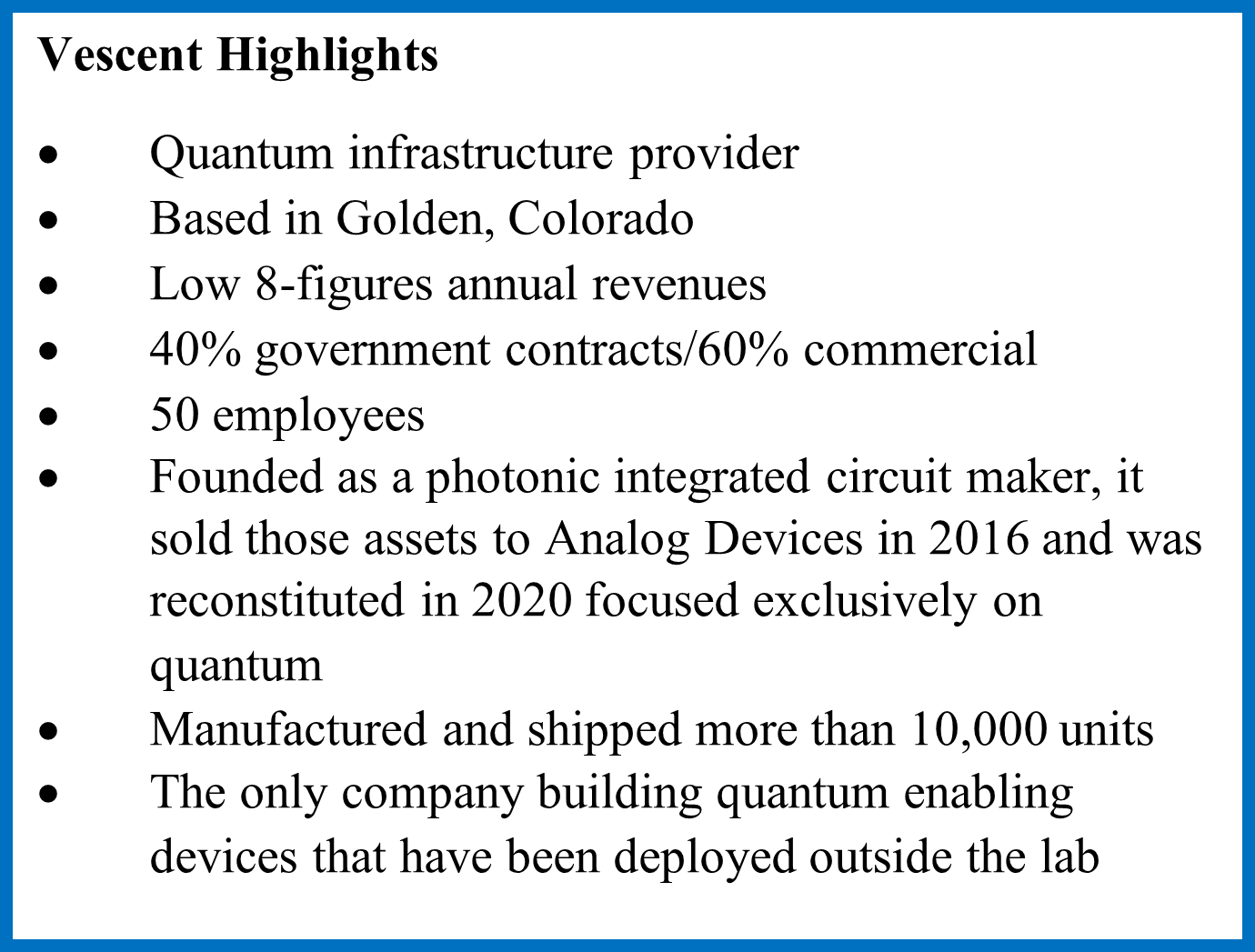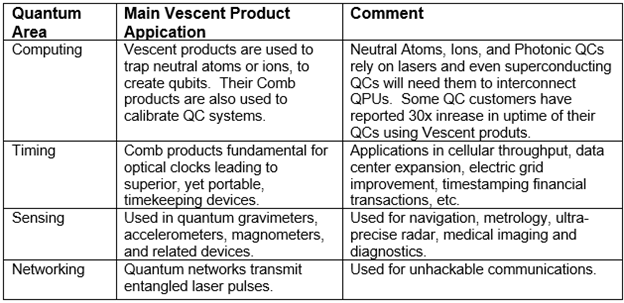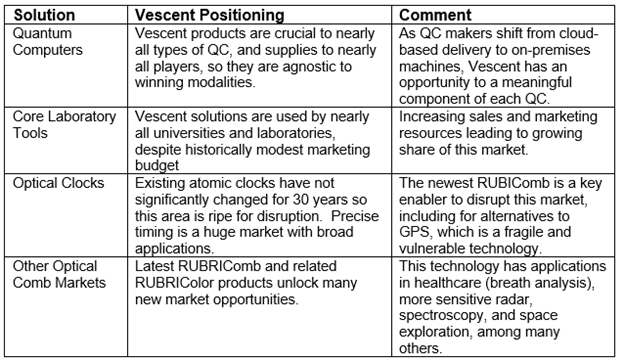Quantum Infrastructure Company - Vescent Technologies, Inc.
Selling enabling solutions to nearly everyone in quantum
Vescent Technologies, Inc. (“Vescent” or the “Company”) is a quantum infrastructure company providing enabling products to nearly all companies and researchers in the broad quantum ecosystem. Understanding Vescent, its products and the markets it serves, can help inform readers about some of the broader dynamics of the quantum industry.
In order to better understand what Vescent does, let’s drill down on some of the fundamental properties of its quantum tools. As readers may already know, the current surge in “quantum” is broadly focused on controlling the extremely small (atoms, photons, electrons) and/or the extremely cold, where non-intuitive properties such as “superposition”, “entanglement” and “particle-wave duality” among other quantum properties occur. While mankind has known about these properties since the early 1900’s and began leveraging them for things like lasers and integrated circuits beginning in the 1960’s, it wasn’t until 1995 that the first two-qubit gate was created (by Chris Monroe and David Wineland at NIST in Boulder, CO). Today, there are 100’s of companies focused on various aspects of commercializing quantum physics for areas that include Quantum Computing, Quantum Sensing, Quantum Networking, and Quantum Clocks. Vescent serves all these markets, so let’s explore how they do that.
We begin with the “photon” which is the smallest possible unit or “quanta” of light. Photons behave both as particles and as waves and this dual nature is one of the weird and fascinating aspects of quantum physics. When photons are emitted from the filament of a standard light bulb, the photons propagate in all directions and include many different colors or wavelengths. For a laser beam, the photons are concentrated or coherent and represent a single wavelength. These differences can be seen below:
In order to use photons, or light, to implement quantum features, lasers are generally used. Lasers are devices that amplify or increase the intensity of light and concentrate it in a highly directional or focused beam. For the balance of this post, we’ll refer to aspects of photons and lasers as “light”, so let’s focus on the core characteristics of light as depicted in the graphic below, which features two different light waves (blue and red lines).
While there are many features of light, it’s useful to focus on three core aspects:
Color: In the visible light spectrum, we are familiar with the various colors of the rainbow, and these colors are a result of differing Wavelengths, shown above as the distance between wave peaks (or troughs). For visible light, this wavelength varies from ~700 nanometers for red, to ~400 nanometers for violet.
Intensity: Light can have varying levels of intensity or brightness, which is a measure of the wave’s height or amplitude. For a laser, there is also the feature of beam size (not depicted above).
Consistency: It is also important for quantum applications for the light’s characteristics to be consistent, generally referred to as having low phase noise. Although the red and blue lines above are identical, they are out of phase. If you visualize a surfer riding a wave, phase noise can be thought of the wave increasing or decreasing in speed during the surfer’s ride.
In quantum applications, such as neutral atom quantum computers, individual atoms are trapped within a specialized laser beam. In order to trap and control an individual atom, that beam must have exquisitely controlled color, intensity and consistency and these are the features that Vescent has perfected. Vescent often refers to itself as a “wrangler of photons” and once the photons are wrangled, amazing things can be done with them.
Background
Vescent was founded in 2002 by Scott Davis, Scott Rommel and Mike Anderson, in Davis’s garage in downtown Denver, where they made waveguides, electro-optics, tunable lasers and electronics for precision laser control. Davis is a PhD physicist trained at NIST, Rommel has broad experience in manufacturing optics components and Anderson, also a PhD physicist, had been a post-doc under Eric Cornell and Carl Wieman and was a primary author of the publication that first reported on the creation of a Bose-Einstein condensate, which was a Nobel Prize winning accomplishment (you can see that paper here). They developed a strong reputation and following in the “Atomic, Molecular and Optical Physics” field, as quantum was originally known, and sold highly reliable, high performing and unique products to many customers throughout the research ecosystem. In 2016, they sold the waveguide and beam steering technologies to Analog Devices (“ADI”) where the three founders also went to work. In 2020 Davis and Rommel left ADI and returned to manage what remained of Vescent, which were the “quantum” solutions that ADI was not interested in. Those early roots and their focus on manufacturing exacting equipment that consistently performed to its specifications, combined with their learnings from their time at ADI, resulted in Vescent punching way above its weight as it relates to manufacturability of their products, and they have enjoyed a long and consistent reputation for selling products with exceptional performance and reliability.
Products
Vescent makes and sells a variety of products, categorized in three product families:
D2 Product Line – For Analog Laser Characterization and Control
The D2 is Vescent’s legacy product line which enjoys somewhat of a cult following. It is comprised of a suite of products with analog controls that enable customers to create and control laser beams to exacting specifications. Many customers enjoy the ability to fine tune the controls to their own requirements. Below is a sample schematic of how the various D2 products interoperate.
SLICE Product Line - For Digital Laser Characterization and Control
The SLICE portfolio is a digitized upgrade of the D2 line, providing an intuitive graphical interface, with easy-to-use controls. Currently Vescent offers five of the six core control boxes, with the remaining product scheduled for release this year. The following graphic depicts this product line.
Lasers
Vescent offers three categories of lasers:
Continuous Wave or CW Lasers: Vescent’s CW laser product family is the D2-200, which comes available with Rubidium, Sodium, Potassium and Cesium wavelengths, covering many of the requirements of existing quantum companies who use those wavelengths. It uses a proprietary lensing system to provide consistency in the beams and is designed to be highly immune to vibrations or acoustic perturbations. These lasers are used in certain atomic clocks, quantum sensors, quantum computers (QC’s) and quantum memory.
Pulsed Lasers: Vescent’s latest product line involves pulsed lasers which are used to create an optical frequency comb, branded as the RUBRIComb, which has a wide range of uses and applications. One primary application is to act as a gearbox to shift between the ultrafast optical frequencies down to the slower radio frequencies used by most existing telecom equipment. Light waves behave a lot like sound waves, so you can think of an optical comb as a device that can translate specific frequencies up or down multiple octaves, which enables frequency combs to be used to tune quantum computers, act as a clock oscillator or for dual-comb spectroscopy enabling ultra precise remote sensing, among other uses. Vescent is also about to release a companion RUBRIColor, which broadens to applicability and wavelength range of the base RUBRIComb.
RUBRIComb (top) and RUBRIColor (bottom)
Distributed Lasers: Vescent also acts as the US distributor of the Stabilaser, an acetylene-stabilized laser manufactured by DFM (the Danish National Metrology Institute), which exhibits a very narrow linewidth, excellent long-term stability and high accuracy. The Stabilaser is an essential component for spectroscopy or laser cooling on narrow-line atomic or molecular transitions.
Customers and Applications
Vescent products and solutions apply to nearly every quantum applications (highlighted in the graphic below) and they sell to nearly every participant in the broad quantum ecosystem.
The following table highlights some examples of how customers use Vescent solutions:
On the Government side of Vescent’s business, the following are a few examples of recent programs:
Vescent has a number of programs with NASA including COCQPITS (compact optical cavities for quantum photonics and integrated timing solutions), which is focused on developing space-based timing/clock technologies. They are developing optical frequency combs for space-deployed clocks and Rydberg-atom based quantum sensors for applications in geodesy, autonomous spacecraft navigation and gravitational wave detection.
Vescent partners with Sandia National Laboratories on the Department of Defense’s Multi-axis Atom-interferometer Grating-chip Inertial Sensor (MAGIS) program to develop an accelerometer for inertial navigation systems. Because GPS is limited by being trivial to jam, easy to spoof, vulnerable to anti-satellite weaponry, and unavailable in certain environments (i.e., underground or underwater) the goal of this program is to develop inertial sensors for navigation that does not require GPS.
Vescent also led an effort, with Infleqtion and Octave Photonics as subcontractors, for the Navy’s Office of Navel Research (ONR) to develop portable atomic clocks capable of ultra-high frequency stability with low size, weight and power (SWaP). The Compact Rubidium Optical Clock (CROC) was designed for deployment on mobile platforms in order to synchronize advanced communications networks and enable ensured positioning, navigation and timing in GPS-denied environments.
Future Prospects
Vescent has an opportunity to increase its market penetration through the expansion of its existing product lines (nearly complete) and its entry into new and important quantum applications especially for field deployed solutions, where Vescent has a unique ability to operate. Vescent is currently working on a suite of new products with small SWaP (size, weight and power) and ruggedness so that they can be deployed in various environments including moving vehicles (planes, helicopters, battleships, etc.) and satellites. Their market opportunities can be summarized in the following table:
Summary
The following SWOT analysis summarizes Vescent’s current business:
Vescent is a significant player in the quantum infrastructure market, selling reliable and exacting tools used by nearly all quantum industry participants. They completed a $5 million seed round in early 2024 and deployed all that capital in the business, focusing on the expansion of sales and marketing resources, the launch of the optical frequency comb, and the expansion of its IP portfolio, all of which is beginning to bear fruit. They have a line-of-sight to increase revenues to $100 million or more in the next 3-5 years, and they are managed by a strong and experienced team. Additionally, they are operating in a market with significant tailwinds with increasing needs for Vescent solutions, including crucial national security imperatives such as alternatives to GPS, ultra-secure communications, the growing quantum computing industry and a broad precision timing market.
Rating
Apropos of the probabilistic nature of quantum algorithms, I wanted to leverage the nomenclature to create a company rating system and assign a scale to my overall assessment of a company’s potential. Accordingly, I am going to use the formula above when reviewing companies, whereby the “alpha” coefficient correlates with “positivity” (and the formula adheres to the Born rule). Given my overall assessment of Vescent including its strong position as a leading quantum infrastructure leader, its broad customer base, strong and growing IP portfolio, and its unique position as the only provider of quantum tools that can be field-deployed, I am assigning the highest rating to Vescent at this time, with an Alpha of 0.95 which equates to an “Exceptional performance expected”.
Disclosure: Corporate Fuel, a firm I am affiliated with, and I have an investment interest in the company discussed in this review. I wrote this article myself and express it as my own opinion. This post should not be used for investment decisions and the content is for informational purposes only.
The Vescent word mark as well as the RUBIComb and RUBRIColor product names are trademarked by Vescent Technologies, Inc.
References:
Diddams, Scott, “Optical frequency combs: Coherently uniting the electromagnetic spectrum,” Science, July 17, 2020
Bulb and Laser Image: https://www.seekpng.com/ipng/u2t4e6i1a9r5q8o0_diagram-of-a-light-bulb-with-lots-of/
Photon Wrangler image generated by an AI model provided by Canva
Wavelength graphic created by Jake Fein
Other images courtesy Vescent Technologies, Inc.





















